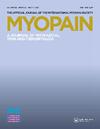Effects of Lumbosacral Angles on Development of Low Back Pain
引用次数: 11
Abstract
Abstract Objective: Low back pain [LBP] is an important health issue due the diagnosis and treatment expenses and loss of workforce it leads to. Biomechanical changes in the vertebral column caused by changes in the lumbosacral angles [LSAs] may lead to LBP. The purpose of this study was to assess body mass index [BMI] and LSAs in patients with LBP and investigate the association between LBP, LSAs and BMI. Methods: Lumbar lordotic angle [LLA], LSA, sacro-horizontal angle [SHA] and sacral inclination angle [SIA] were measured in 117 patients with chronic LBP and 85 healthy normal controls [HNCs] by means of lumbosacral radiography. In addition, association between LSAs, BMI and LBP was investigated. Results: There were no significant differences between patients and HNCs regarding LSAs and BMI. LLA was lower in male patients with LBP compared to male HNCs without LBP [p = 0.013]. In addition, SIA [p = 0.002] and BMI [p = 0.006] were higher in female patients with LBP compared to male patients with LBP. It was found that an increase in LLA increased the risk of having LPB by approximately 1.04-folds [ranging from 1.01 to 1.08; p = 0.045]. On the other hand, no association was found between LSAs and BMI. Conclusion: Changes in LSAs may cause LBP. An increase in LLA may be influential in increasing the risk of LBP. Therefore, measurement of LSAs may guide the physician who is to make clinical decisions in examination of patients with LBP.腰骶角对腰痛发展的影响
摘要目的:腰痛(LBP)是一个重要的健康问题,因其导致诊治费用和劳动力损失。腰骶角(LSAs)变化引起的脊柱生物力学变化可导致腰痛。本研究的目的是评估下腰痛患者的体重指数(BMI)和LSAs,并探讨LBP、LSAs和BMI之间的关系。方法:对117例慢性腰痛患者和85例健康正常人(HNCs)进行腰骶部x线摄影,测量腰前凸角(LLA)、腰骶水平角(SHA)、骶倾斜角(SIA)。此外,还研究了LSAs、BMI和LBP之间的关系。结果:在LSAs和BMI方面,患者与HNCs之间无显著差异。有LBP的男性HNCs患者LLA低于无LBP的男性HNCs [p = 0.013]。此外,女性LBP患者的SIA [p = 0.002]和BMI [p = 0.006]高于男性LBP患者。研究发现,LLA的增加使LPB的风险增加了约1.04倍[范围从1.01到1.08;p = 0.045]。另一方面,没有发现LSAs和BMI之间的关联。结论:LSAs的改变可能引起LBP。LLA的增加可能对LBP的风险增加有影响。因此,LSAs的测定可以指导医生在检查腰痛患者时做出临床决策。
本文章由计算机程序翻译,如有差异,请以英文原文为准。
求助全文
约1分钟内获得全文
求助全文

 求助内容:
求助内容: 应助结果提醒方式:
应助结果提醒方式:


